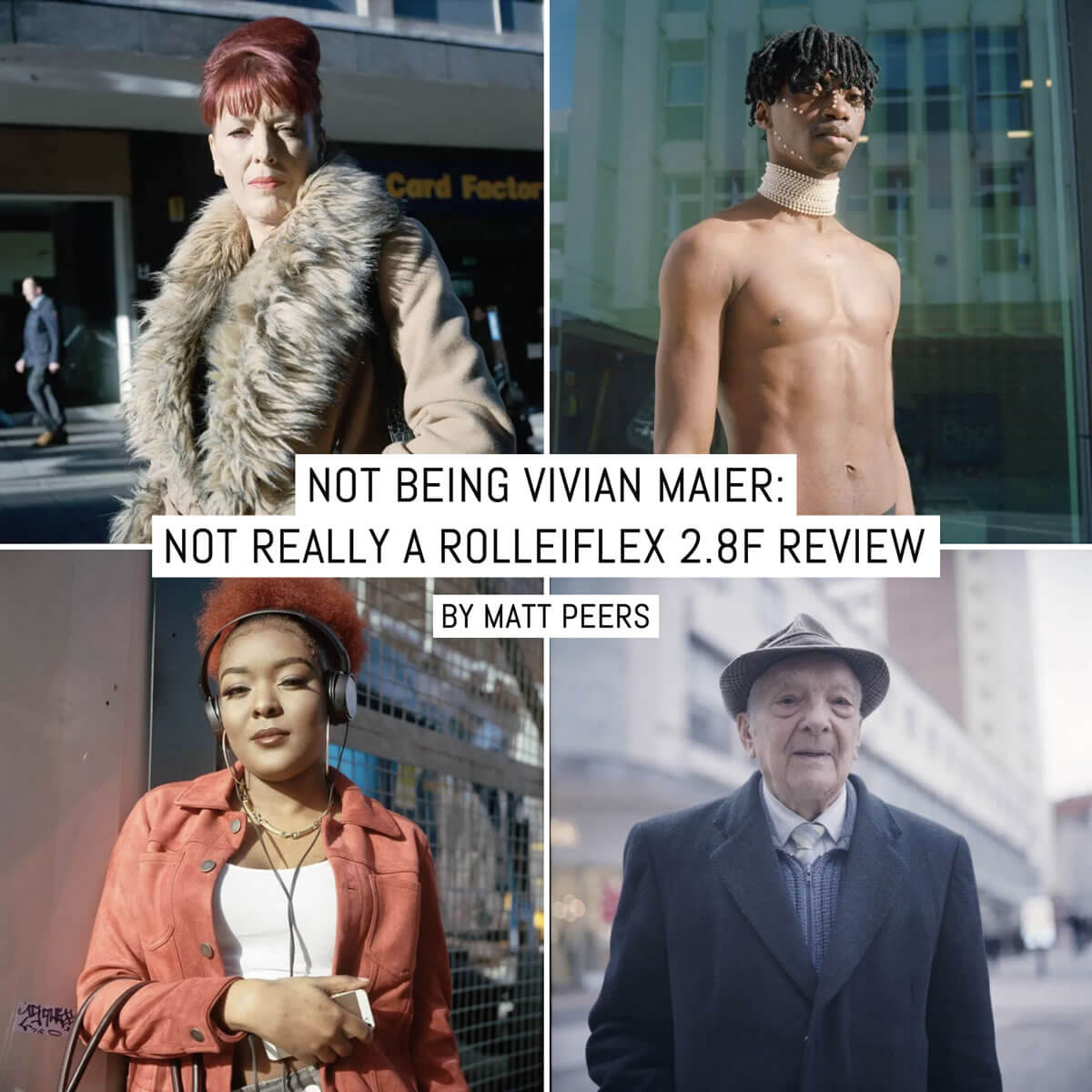It has nearly been 12 months since I got my hands on my Rolleiflex 2.8F, and whilst I’m not usually a reviewer of equipment, I’d like to share my experience of using this iconic camera and the inspiration behind me finally owning one.
Like many who were first made aware of the story of Vivian Maier, I was completely captivated by the romantic ideal of pounding the streets, donning a cloak of invisibility and viewing the world through the focusing screen of a Rolleiflex. I’m a middle-aged, middle class (looking) bald white man, so invisibility certainly isn’t a problem.



The camera’s waist level view finder means that to compose an image you are looking down, avoiding eye contact, making it even better for the undetected, Maier-esque capture. There’s only one thing I’d not considered…the camera is too iconic, too exotic for people to ignore.
I’ve been doing street and social portraiture for some years now, using a mixture of digital and film cameras. Rarely are people interested in the camera I’m using, apart from maybe some forgetting that they can’t see an image on the back of a film camera. But with the Rollei, it’s a completely different story. It’s stared at, pointed at and more often than not, starts a conversation just by being there. In short, it’s like having an E-Type Jag around your neck.


Times have changed and Rolleis are now exotic creatures compared to DSLRs and smart phones; invisibility is not a realistic expectation with one in your mitts. Instead of stealth, I embraced the camera’s allure and continued to ask people for their portraits. I’m used to asking random strangers for their portrait; the quizzical looks and rejections, but with the Rollei, the ratio of people agreeing straight away went from 50/50 to 80/20.
As this was my first TLR camera I wasn’t used to composing an image from such a low view point. Portraits tend to have a looking up to your subject view, which isn’t always flattering – but it can create an interesting dynamic between subject and viewer.


Focusing and composing can be tricky if you’re new to TLRs. The image on the focus screen is reversed left-to-right which makes it harder to coordinate your hand and eyes when you want to make sure your horizontal levels are correct.
You do get over this optical trickery on your brain quickly and can get on with the business of finding your desired composition. Changing aperture and shutter speeds are either side of the body and an easy thumb change away between f/2.8 and f/16 and 1s – 1/500th respectively. The selenium powered light meter is quite accurate where the conditions are not so complex, however I have under exposed on the few occasions I trusted the meter.


For me a camera is far more than a pretty object or means to an end – it’s a trusted friend that you bond with, understand and accept its foibles and strengths and in turn that relationship helps shape the work you create. The Rollei is far from the most practical camera to use, especially when images require a change of lens or off the cuff compositions.
It is though, a joy to hold, to wind to the next frame and find your subject solidify in to focus on the square glass screen. And once you have the medium format negative you can properly appreciate the detail and characteristics of the Carl Zeiss Planar lens.


I’ve dedicated a project to the street portraits created exclusively using the Rollei, called New Faces. It’s title is partly inspired by the original and best talent show from the 1970s and the experience of the subject emerging on the focusing screen. It may not contain the same style of unsuspecting subjects taken by Maier, but I hope in small way they too can be an archive in their own right one day.
‘Til next time,
~ Matt
Share your knowledge, story or project
The transfer of knowledge across the film photography community is the heart of EMULSIVE. You can add your support by contributing your thoughts, work, experiences and ideas to inspire the hundreds of thousands of people who read these pages each month. Check out the submission guide here.
If you like what you’re reading you can also help this passion project by heading over to the EMULSIVE Patreon page and contributing as little as a dollar a month. There’s also print and apparel over at Society 6, currently showcasing over two dozen t-shirt designs and over a dozen unique photographs available for purchase.












14 responses to “NOT Being Vivian Maier: NOT really a Rolleiflex 2.8F camera review”
I’ve noticed the same thing about it being hard to “disappear” when shooting with a rolleiflex! It has this history of being a great “Street camera” but no more. In the 21st century, that much black chrome art deco really stands out. I also love using my 2.8e, but usually run into this same issue.
I think we are made for a different time Dewayne….
Ahhhh this work is just so fine. The Rolleiflex is still #lifegoals for me. Use it well!
Thanks Magnus! Make sure you achieve that life goal…take care.
Killer portraits, really beautiful work.
Thank you Neil, I really appreciate it.
Great work!
Cheers RJ. I think it was 1/30 and holding my breath!
Great stuff Matt
Cheers Tom.
Really excellent work. Vivian was always my favorite out of the Young Ones.
Thanks Philip…although Rik was the better photographer…
Thanks RJ. I think it was 1/60 at f4 and a dollop of luck.
These are awesome images Matt! Do you recall the shutter speed you got with the self portrait? I never thought one could get a decent exposure like that with 400 speed film.